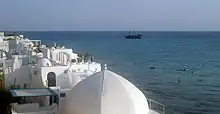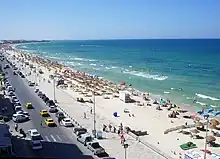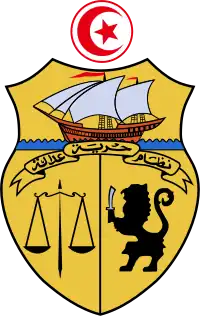.JPG.webp)
Tourism in Tunisia is an industry that generated around 9.4 million arrivals per year in 2016-2020, which makes it one of the most visited countries in Africa. Tunisia has been an attractive destination for tourists since the beginning of the 1960s.
Among Tunisia's tourist attractions are its cosmopolitan capital city of Tunis, the ancient ruins of Carthage, the Muslim and Jewish quarters of Djerba, and coastal resorts outside Monastir. According to The New York Times, Tunisia is known for its "golden beaches, sunny weather, and affordable luxuries."[1]
History

According to Garrett Nagle in his book Advanced Geography, Tunisia's tourist industry "benefits from its Mediterranean location and its tradition of low-cost package holidays from Western Europe."[2] The development of tourism dates back to 1960 through the joint efforts of government and private groups. In 1962, tourism, with 52,000 entries and 4,000 beds, had a revenue of two million dollars and became the main source of foreign exchange in the country.[3]
Tunisia is also an attractive destination for its huge number of important festivals. The majority of these festivals occur in summer such as International Festival of Carthage which is the most important festival in the Arab world hosting stars and bands from all over the world, and Tabarka Jazz Festival.
Until recently, Tunisia's main attraction was on its northeast coastline around Tunis; however, the Seventh National Development Plan of 1989 created several new tourist areas including the resort at Port-el-Kantaoui.[2] The tourism sector now represents 6.5% of Tunisia's GDP and provides 340,000 jobs of which 85,000 are direct jobs or 11.5% of the working population with a high share of seasonal employment.
France, Germany, Italy and the United Kingdom are the four traditional tourist markets, though Tunisia has decided in the last few years to open its tourism industry to new markets such as Russia and China.[4] From 2003 to 2004, it regained tourists, and 2007 saw arrivals increasing by 3 percent over that of 2006.[4]
Tourism in Tunisia suffered severe blows following the Bardo National Museum attack and the Sousse attack in 2015,[5] but Tunisia managed to retrieve its position as one of the top destinations in Africa and the Mediterranean shortly afterwards, reaching in 2018 numbers exceeding those of 2010 by 6 percent,[6][7] and a record of 8.3 million visitors.[8]
The consequences of the COVID-19 pandemic on Tunisia's tourism sector have been described as catastrophic. In 2020 earnings were down 60% to US$563 million.[9]
Attractions
Tunisia's attractions are of different types according to the region:
- Tunis, the largest city and capital and its suburbs mainly Le Bardo, and the northern suburbs of Carthage, Sidi Bou Said, La Goulette and La Marsa
- Bizerte and its surroundings
- The North-West for its forests in Ain Draham and picturesque coastal mountains close to Tabarka
- The Cap Bon: Hammamet, Nabeul and surroundings
- The Sahel, Tunisia: the beach resorts of Sousse, Monastir, Mahdia
- The religious city of Kairouan, the former capital of the country, the fourth capital of Islam and the city of the oldest mosque in Africa Great Mosque of Kairouan
- The island of Djerba
- The Sahara and the touristic and relaxing cities of Douz, Tozeur and the famous Tataouine, one of the locations of the Star Wars saga.
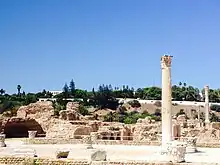 The archeological site of Baths of Antoninus in Carthage |
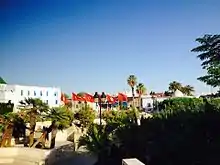 La Kasbah Square in Tunis |
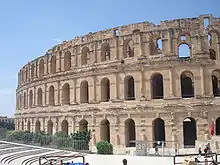 Amphitheatre of El Jem, the biggest in the world outside of Rome |
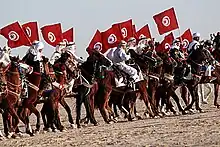 International Festival of the Sahara |
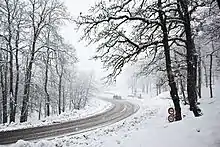 Snowfall in Tabarka |
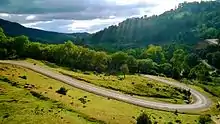 Forest near Aïn Draham |
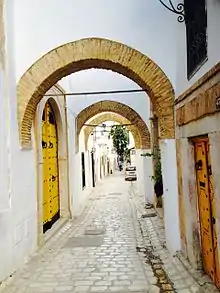 Medina of Tunis, a UNESCO world heritage site |
UNESCO World Heritage Sites
Tunisia is home to eight UNESCO World Heritage Sites as well 13 others in the tentative list including the island of Djerba for its cultural and religious diversity.
| Site | Image | Location | Area ha (acre) |
Year | Description |
|---|---|---|---|---|---|
| Archaeological Site of Carthage | 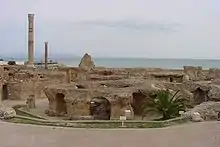 |
Tunis Governorate 36°51′10″N 10°19′24″E / 36.85278°N 10.32333°E |
616 (1,520) | 1979 | Founded in the 9th century BC, Carthage developed into a trading empire spanning the Mediterranean. The city was destroyed in 146 BC in the Punic Wars at the hands of the Romans, but was later reestablished.[10] |
| Dougga / Thugga | 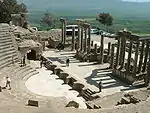 |
Béja Governorate 36°25′25″N 9°13′13″E / 36.42361°N 9.22028°E |
70 (170) | 1997 | The site features the ruins of Dougga, a former capital of a Libyan–Punic state, which flourished under the Romans and the Byzantines, but went into decline in the Islamic period.[11] |
| Amphitheatre of El Jem |  |
Mahdia Governorate 35°17′47″N 10°42′25″E / 35.29639°N 10.70694°E |
1.37 (3.4) | 1979 | Built during the 3rd century, the Amphitheatre of El Jem is North Africa's largest amphitheatre, and the largest one built outside of Italy, with a capacity of 35,000 spectators, regarded as among the most accomplished examples of Roman architecture of its kind.[12] |
| Ichkeul National Park | 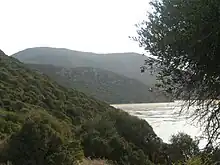 |
Bizerte Governorate 37°09′49″N 9°40′29″E / 37.16361°N 9.67472°E |
12,600 (31,000) | 1980 | Ichkeul Lake and the surrounding wetlands is a destination for hundreds of thousands of migrating birds, including ducks, geese, storks and pink flamingos. It was once part of a chain that extended across North Africa.[13] |
| Kairouan | 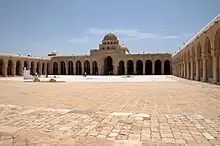 |
Kairouan Governorate 35°40′54″N 10°06′14″E / 35.68167°N 10.10389°E |
68 (170) | 1988 | Founded in 670, Kairouan was the former capital of Ifriqiya and flourished in the 9th century. Its heritage includes the Mosque of Uqba and the Mosque of the Three Gates.[14] |
| Medina of Sousse | 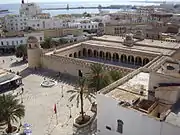 |
Sousse Governorate 35°49′40″N 10°38′19″E / 35.82778°N 10.63861°E |
32 (79) | 1988 | A prime example of a town from the early Islamic period, Sousse was an important commercial and military port during the 9th century.[15] |
| Medina of Tunis | 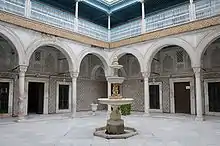 |
Tunis Governorate 36°49′00″N 10°10′00″E / 36.81667°N 10.16667°E |
296 (730) | 1979 | The Medina of Tunis contains some 700 monuments, including palaces, mosques, mausoleums, madrasah and fourtains, testifying to Tunis' golden age from the 12th to the 16th century.[16] |
| Punic Town of Kerkuane and its Necropolis |  |
Nabeul Governorate 36°56′47″N 11°05′57″E / 36.94639°N 11.09917°E |
— | 1985 | Abandoned in 250 BCE during the First Punic War and never rebuilt, Kerkuane is the only surviving example of a Phoenicio–Punic settlement.[17] |
Museums
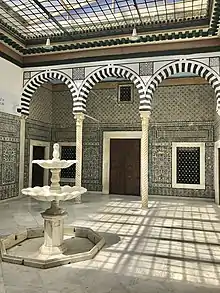
This is a list of some important museums in Tunisia:
| Name | City | Type | Year established |
|---|---|---|---|
| Bardo National Museum (Tunis) | Tunis | National museum | 1888 |
| Carthage National Museum (formerly known as the Lavigerie Museum) | Carthage | National museum | 1875 |
| Sousse Archaeological Museum | Sousse | Archaeological museum | 1951 |
| Musée Dar Cheraït | Tozeur | History museum | 1990 |
| Dar Jellouli Museum | Sfax | Art museum | 1939 |
| El Djem Archaeological Museum | El Djem | Archaeological museum | 1970 |
| Musée des arts et traditions populaires de Djerba | Djerba | History museum | 2008 |
| Musée des arts et traditions populaires de Monastir | Monastir | History museum | |
| Musée des arts et traditions populaires de Tunis | Tunis | Art museum | 1978 |
| Musée du patrimoine insulaire de Kerkennah | Kerkennah | History museum | 2006 |
Resorts
This sector is popular mainly on the east coast, totaling more than 95% of beds. The following is a list of the largest resorts and the percentage of nights out of the total:
Golf
Tunisia is also a pioneer golfing destination in the Mediterranean. It offers world-class golf courses available year-round due to the sunny and pleasant weather. Among the most important golf courses of the country:[18]
- Yasmine Valley in Hammamet
- Citrus (La Foret) in Hammamet
- El Kantaoui (Panorama) in Port El Kantaoui
- Tabarka golf course
- Citrus (Les Oliviers) in Hammamet
- Residence Tunis in Gammarth
- Flamingo Monastir
- El Kantaoui (Sea) in Port El Kantaoui
- Djerba (La Mer and Les Palmiers)
- Carthage golf course in La Soukra
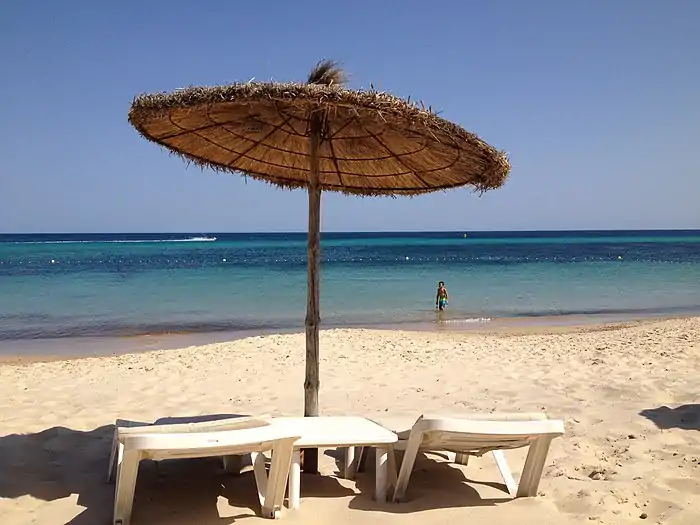
Marinas
Tunisia is one of the African countries that has the most marinas. Its yachting infrastructure attracts mostly European tourists who flee the harsh winter in their home countries to enjoy the pleasant weather and relatively warmer sea in Tunisia. The country is planning to create additional marinas in the coming years such as the one in the new modern economic center of Tunis Financial Harbor.
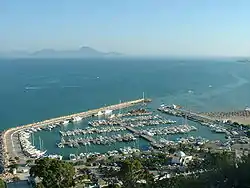
The existing marinas are 8 from the north to the south of the coast:
- Yasmine Hammamet Marina in Hammamet
- Bizerte Marina in Bizerte
- El Kantaoui Marina in Port El Kantaoui
- Sidi Bou Said Marina
- Gammarth Marina
- Tabarka Marina
- Marina Cap in Monastir
- Djerba Marina
Theme parks
Tunisia offers several theme parks and most importantly water parks in each of the main cities and tourist resorts and among them:[19]
- Carthage Land in Hammamet
- Aqua Palace in Sousse
- Aqua Splash in Sousse
- Aqua Land in Yasmine Hammamet
- Dreamy Sea Waterpark in Hammamet
- Aqua land in Berges du Lac, Tunis
- Big Splash in Djerba
- Le Pirate in Djerba
Desert and film sets
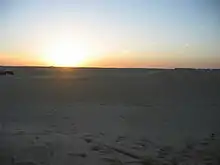
The Tunisian desert represents a major tourist destination in the country. The oases add some greenness and shade to the aridity of the pristine environment and the hot sun of the Saharan dunes.
Since the Arab invasions on Tunisia, a growing population settled in the arid environment of the Numedian regions Medenine, Tataouine and Tozeur where they created oases as havens and also souks and old towns as new urban centers.[20]
Tozeur benefited from its extremely authentic old town and its souks to develop the tourism industry especially for the winter and spring seasons. Several hotels and maisons d’hote opened in Tozeur as well as some upscale units such as the world-famous Thai brand, Anantara in 2019 which is ranked as the best hotels in the world.[21]
Taking a horse carriage to visit the oases and to taste the delicious Deglet Nour as well as going to Chott el Djerid, the largest salt lake in the Sahara Desert are must-do activities in the region.[22] The canyons and rocky mountains of the south as in Mides and the Berber village of Chebika, Tozeur can be visited while taking the old and luxurious Lézard rouge train for a few ride hours stopping at many natural stations.
With Lucas's Star Wars, Tataouine and Matmata's underground houses became tourist destinations. Numerous other Hollywood movies were filmed in the Tunisian south, such as The English Patient.[20]
Festivals and nightlife
During the summer, Tunisia becomes the venue of a multitude of festivals welcoming Arab and world-famous stars as International Festival of Carthage, Hammamet International Festival and Djem Symphonic Festival. Outdoor bars and nightclubs have made of Tunisia's metropolitan areas very lively during the whole day in the summer and at night especially in Gammarth [23] and Hammamet.
Shopping
Souks and historical handicraft markets are present in the old towns of the country. They used to represent the commercial center of each city but they are now major tourist attractions. The old souks of Tunis for example have separated sections for each type of handicraft such as for the Chechia, the jewelry, etc.
Modern shopping infrastructure has also developed in the recent years attracting big international brands. Despite the creation of many new shopping malls such as Tunisia Mall in Berges du Lac, Mall of Sousse and Azur City Mall in the southern suburb of Tunis, they are all located in the capital city or in the coastal touristic cities.
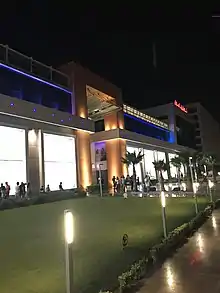
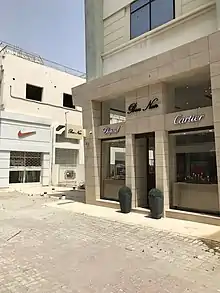
New developments
In recent years, ecotourism, spas and medical tourism are emerging into Tunisia's tourist scene and growing very fast. According to the former Minister of Tourism Ahmed Smaou, "The medical tourism has a great future ahead of us."[24]
Statistics
In 2000, there were 197,400 hotel beds in roughly 95,977 rooms with an occupancy rate at 56%.[25] 5,057,193 travellers came to Tunisia that year.[25] That year, tourist expenditures were nearly $1.5 billion.[25] According to 2002 US Department of State estimates, the average daily cost of staying in Tunis or Carthage was $146, compared to $114 in other areas of Tunisia.[25]
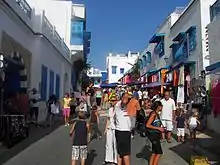
A large number of tourists to Tunisia come from Eastern Europe, and the nationalities of major tourist countries is shown here: Libyans (1,472,411 visitors), French (1,234,735), Algerians (945,324), Germans (547,403), Italians (464,323) and British (350,693).[3] There were 1,251,251 domestic tourists staying across the country for 2.75 million nights in 2006.[26]
Recent years
| Year | Arrivals (million) | Earnings (dinar) |
|---|---|---|
| 2010 [27] | 6.902.749 | 3.522,5 |
| 2011 [28] | 4.781.896 | 2.432,6 |
| 2012 [29] | 5.590.464 | 3.175,3 |
| 2013 [30] | 6.268.582 | 3.229,4 |
| 2014 [31] | 6.068.593 | 3.575,6 |
| 2015 [32] | 5.359.309 | 2.354,6 |
| 2016 [33] | 5.724,021 | 2.322,9 |
| 2017 | 7.051.993 | 2.713,1 |
| 2018 | 8.300.000 | 4.093,0 |
| 2019 | 9.429.000 | 5.612,2 |
See also
References
- ↑ Elaine Glusac (22 November 2009). "A Night, and Day, In Tunisia at a New Resort". The New York Times.
- 1 2 Nagle, Garrett (2000). Advanced geography. Oxford University Press. p. 417. ISBN 0199134073.
- 1 2 Bouamoud, Mohamed (2007-11-12). "Radioscopie du Tourisme tunisien 2003-2006". Webmanagercenter (in French). Archived from the original on 2008-04-30. Retrieved 2008-05-27.
- 1 2 Heyer, Hazel (2008-03-12). "Tunisia tourism moves forward by sticking to the old". eturbonews.com. Retrieved 2008-05-27.
- ↑ Chetcuti, Kristina (9 July 2015). "Maltese strike Tunisia off destination list". Times of Malta. Retrieved 9 July 2015.
- ↑ Kraus, Nils (28 May 2018). "Tourism in Tunisia is Finally Recovering". Tourism-Review. Retrieved 30 August 2018.
- ↑ Tunisia sees tourism take off after terror fears
- ↑ Tunisia tourism revenues jump by 45%
- ↑ "Pandemic impact on Tunisia tourism 'catastrophic'".
- ↑ "Archaeological Site of Carthage". UNESCO. Retrieved 17 August 2011.
- ↑ "Dougga / Thugga". UNESCO. Retrieved 17 August 2011.
- ↑ "Amphitheatre of El Jem". UNESCO. Retrieved 17 August 2011.
- ↑ "Ichkeul National Park". UNESCO. Retrieved 17 August 2011.
- ↑ "Kairouan". UNESCO. Retrieved 17 August 2011.
- ↑ "Medina of Sousse". UNESCO. Retrieved 17 August 2011.
- ↑ "Medina of Tunis". UNESCO. Retrieved 17 August 2011.
- ↑ "Punic Town of Kerkuane and its Necropolis". UNESCO. Retrieved 17 August 2011.
- ↑ "Top 100 Golf Courses - Tunisia". top 100 golf courses.
- ↑ "Les parcs aquatiques en Tunisie". Tunisie.co. Retrieved 27 July 2018.
- 1 2 "Escaoades – Tozeur, perle du sud". lepetitjournal.com. Retrieved 30 May 2019.
- ↑ "A Tatooine journey in Tunisia with Anantara Tozeur Resort". www.incentivetravel.co.uk. Retrieved 20 December 2019.
- ↑ "Anantara debuts in North Africa with launch of Anantara Tozeur Resort in Tunisia". www.traveldailynews.com. Retrieved 3 December 2019.
- ↑ Modak, Sebastian (29 October 2019). "Don't Sleep on Tunis, a City That's More Awake Than Ever Before". New York Times. Retrieved 29 October 2019.
- ↑ Hoorman, Chloé (2005-01-10). "Le grand bain de la mondialisation". L’Express (in French). Archived from the original on 2008-02-28. Retrieved 2008-05-27.
- 1 2 3 4 "Tunisia: Tourism, travel, and recreation". Nations Encyclopedia. Retrieved 2008-05-28.
- ↑ Skander, Galia (2007-12-25). "Le tourisme intérieur : un vrai potentiel négligé". Tunisie Affaire (in French). Archived from the original on 2008-05-17. Retrieved 2008-05-27.
- ↑ (in French) Tourisme en chiffres pour l'année 2010
- ↑ (in French) Tourisme en chiffres statistiques-2011
- ↑ (in French) Tourisme en chiffres statistiques-2012
- ↑ (in French) Tourisme en chiffres statistiques-2013
- ↑ (in French) Réalisations du secteur touristique en 2014
- ↑ (in French) Réalisations du secteur touristique en 2015
- ↑ (in French) Réalisations du secteur touristique en 2016
